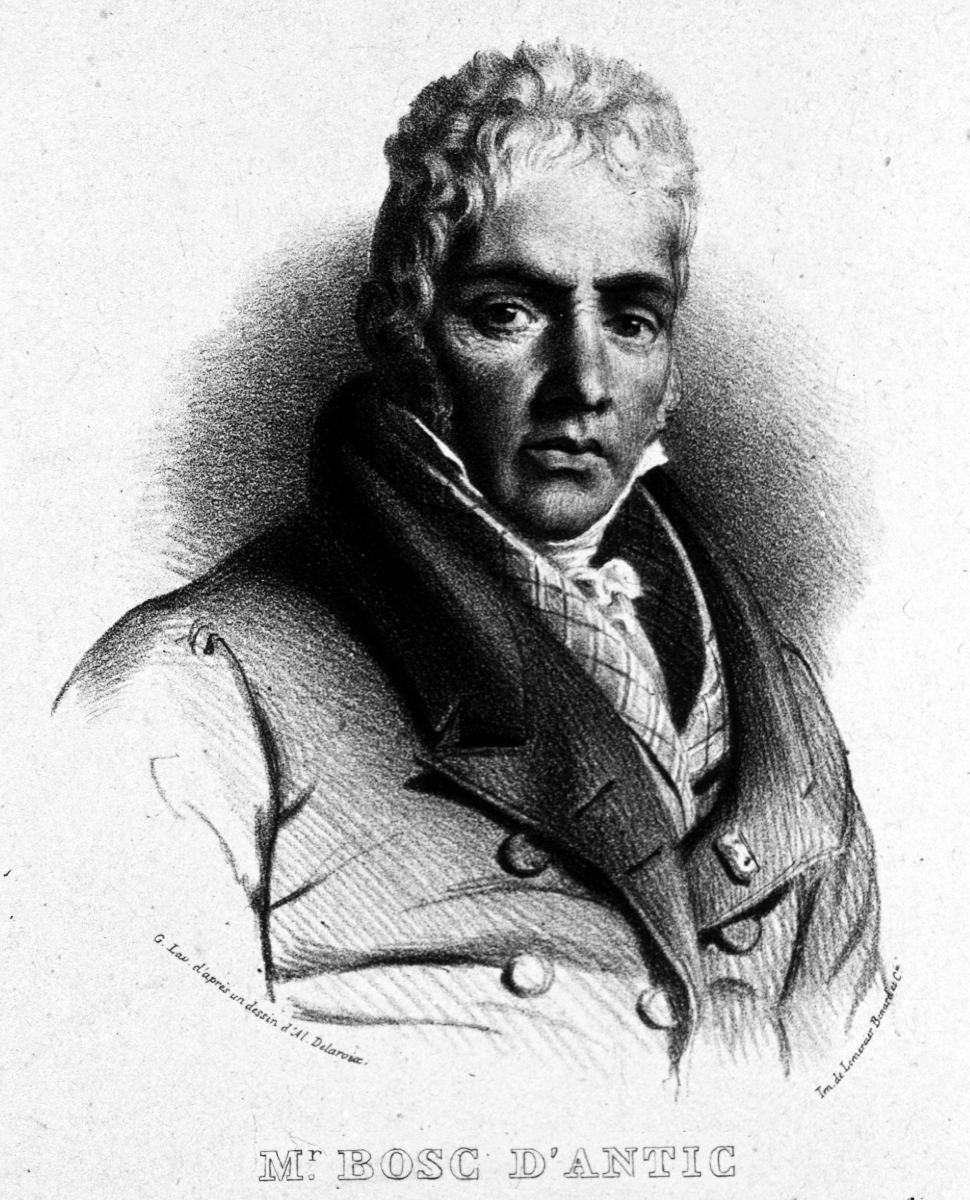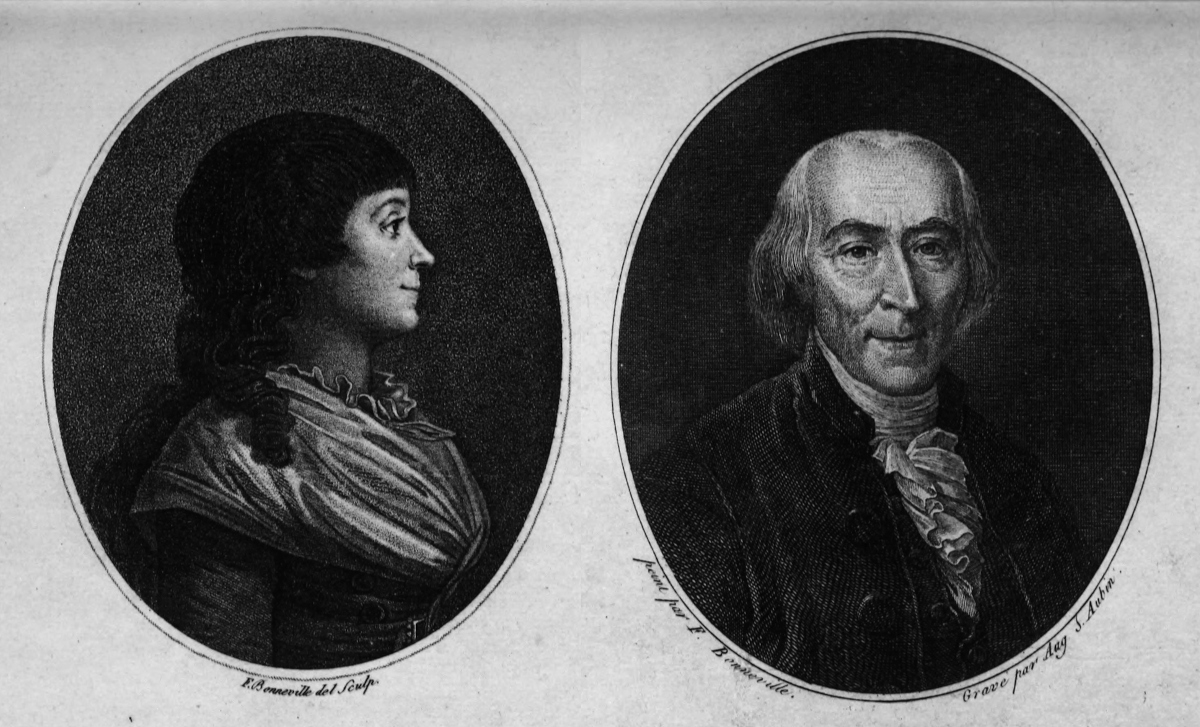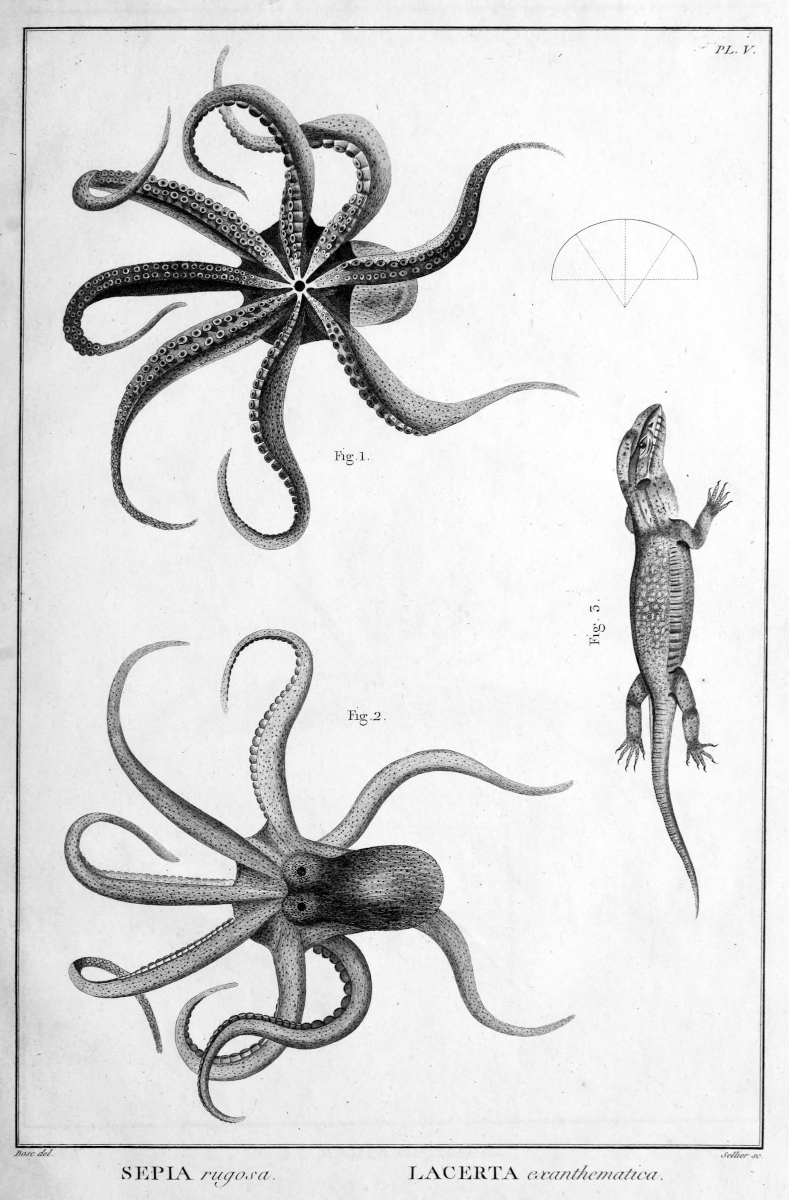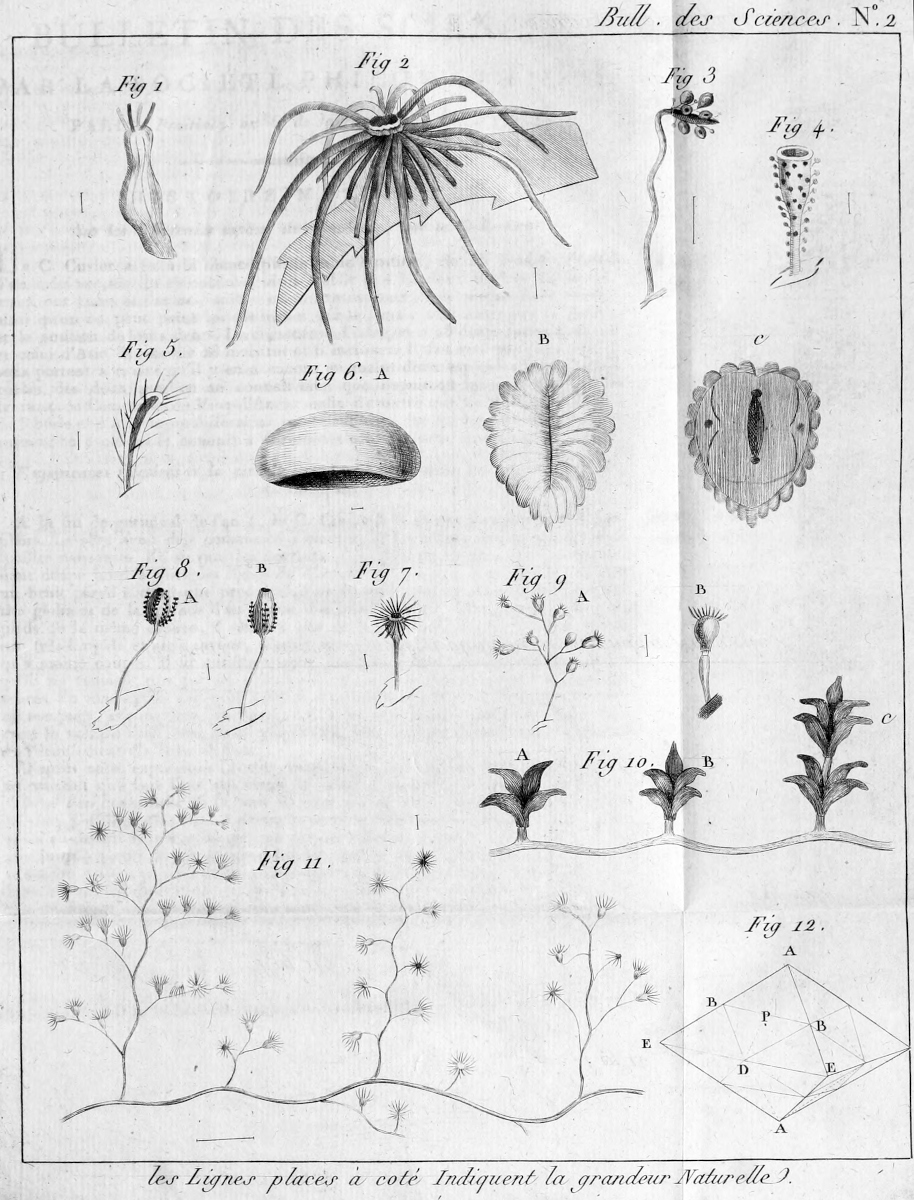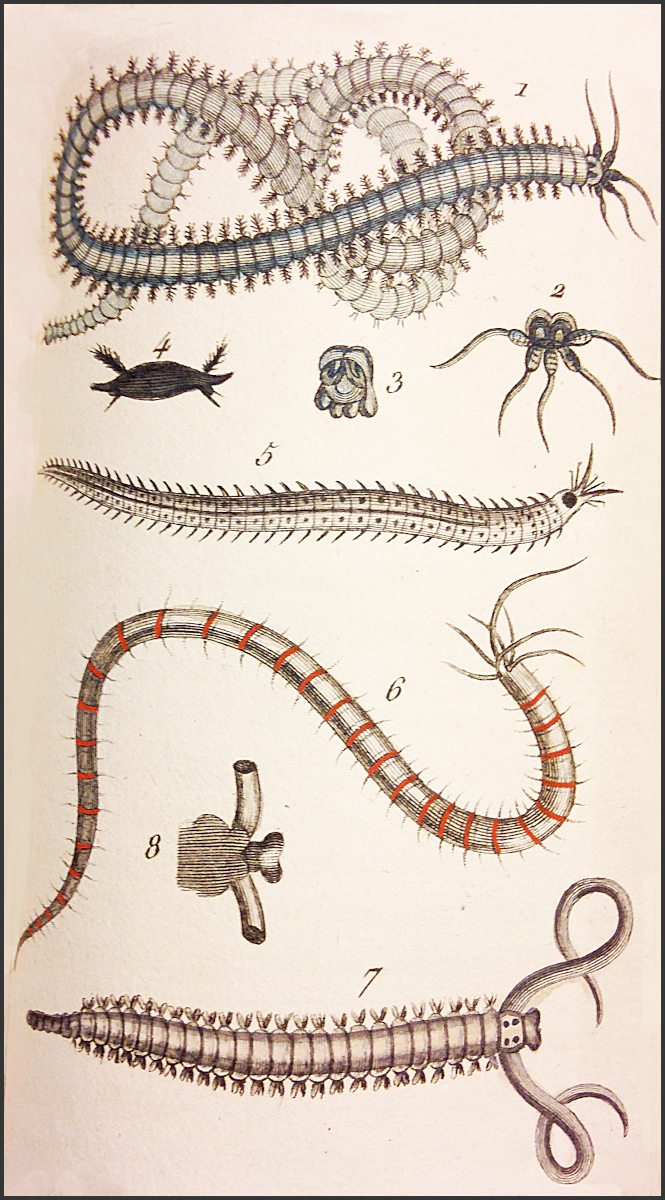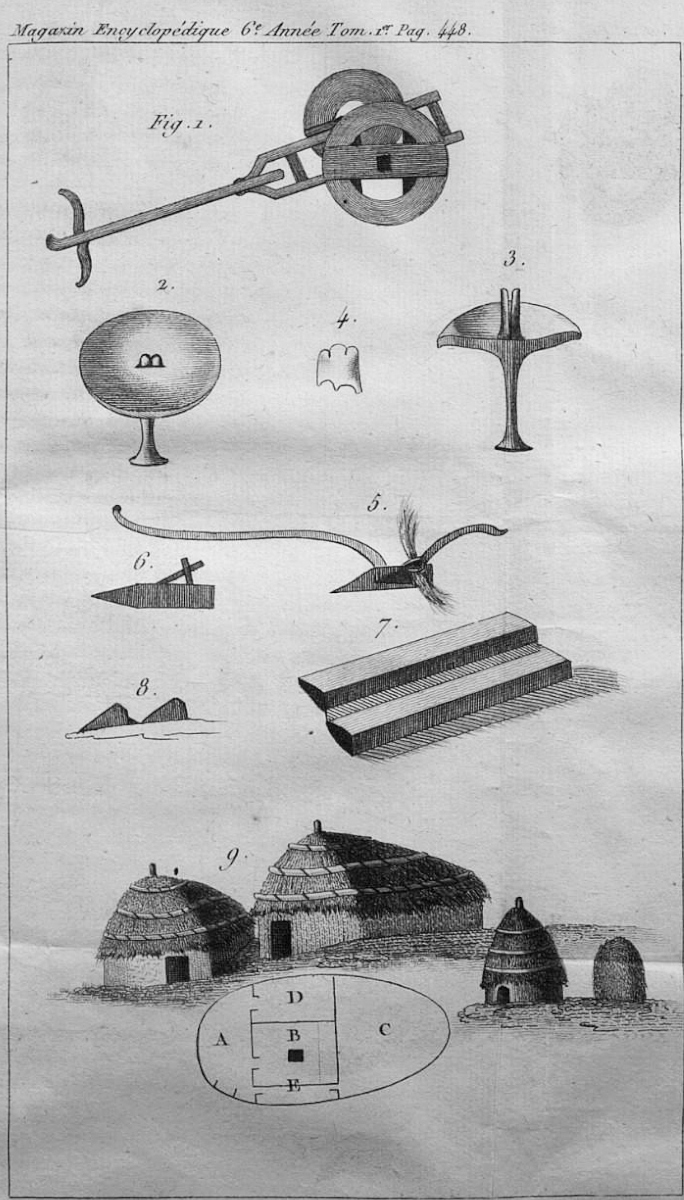"One must be a citizen before being a naturalist" - The story of Louis Bosc, a Linnean in a time of the French Revolution
“Il faut être un citoyen avant d’être un naturaliste” - L’histoire de Louis Bosc, un Linnéen au temps de la Révolution française
- John R. Dolan
|
Louis Bosc (1759-1828) was a naturalist, one of the very first "Linneans" of France, and among the founders of the first Linnean Society, the Société Linnéenne de Paris. The early part of his career as a naturalist coincided with the Revolutionary Period in France (1789-1799). During that chaotic period, he published over 30 articles with many species descriptions, 18 of which are currently recognized as valid. Here his complicated life, professional and personal, during the chaotic period of the French Revolution is described. Keywords: Linnean society, Paris - Zoology - Natural history - French Revolution - History of science Louis Bosc (1759-1828) était un naturaliste, un des premiers Linnéens de France et compte parmi les fondateurs de la première société linnéenne, la Société Linnéenne de Paris. Les débuts de sa carrière de naturaliste ont coïncidé avec la Période Révolutionnaire (1789-1799). Durant cette période, il a publié une trentaine d'articles et décrit un grand nombre d'espèces dont 18 sont aujourd'hui considérées comme valides. Sa vie compliquée à la fois sur le plan professionnel et personnel, pendant la période chaotique de la Révolution Française, est ici décrite. Mots clés : Société linnéenne de Paris - zoologie - histoire naturelle - Révolution française - histoire des sciences |
The naturalist Louis Bosc in pre-Revolutionary Paris
Bosc during the Constitutional Monarchy (1789-1792)
The return of Bosc's friends, the Rolands
|
This is the story of an early French Linnaean, focusing on his life during the years of the French Revolution (1789-1799). A naturalist during a long ago tumultuous time may at first appear to be an odd topic. However, I believe his story to be of potential relevance today. Increasingly, scientists are urged to act in the public sphere. It may then be useful to look a back on a period in which acting in the public sphere was common for naturalists. In addition, the little-known tale of Louis Bosc with it surprising turns and twists merits telling.
Louis Bosc (Fig. 1) was born in 1759, as Louis Bosc d'Antic, into a relatively well to do protestant family. Both his grandfather and father were doctors. His father was a corresponding member of the Académie Royale des Sciences, writing on topics of both medicine and glass making. His mother, of a distinguished military family, died shortly after his birth and he spent his first 5 years in the care of a maternal aunt living in a small village and his second 5 years in with his re-married father in Servin, surrounded at the time by the forests of Bassigny which he explored from early on. From age 10 to 18 he attended a Jesuit college in Dijon and was destined for a military career in the artillery given his family connections. However, he showed little inclination to pursue that pathway and managed to obtain permission during his last 2 years to attend botany classes at the Academy of Sciences of Dijon. Louis Bosc's father, after 2 failed ventures in glass manufacture, returned to practicing medicine, but in Paris, and with the distinction of being one of the Doctors to his Majesty the King. He brought his son Louis with him to Paris and through his connections, obtained in 1778 for the 19-year old, an administrative job in the Poste aux Lettres (Post Office) in Paris.
|
|
The young Bosc rose quickly through the ranks in the administration of the Poste aux Lettres to become secretary to one of the directors by 1782. During his early years in Paris he attended public classes in chemistry, mineralogy and notably those of Broussonet in Botany, his introduction to Linnaeus. However, it was attending botany classes given by Jussieu in the Jardin du Roy in 1780 that Louis Bosc came to know the newly-wed couple M. and Mme. Roland. The close relationship he developed with Rolands would play a very large role in the course of his life (Reynolds, 2012). In 1780, Jean-Marie Roland was a mature, 46 year-old former inspector of manufactures married to the young (26 years old) and vivacious Marie-Jeanne Roland (Fig. 2). The Rolands were in Paris because Jean-Marie Roland had been summoned to help draft new manufacturing regulations. Task accomplished in early 1781, the Rolands left for the provinces, not to return to Paris until 1791, year 2 of the Revolution. However, Louis Bosc and the Rolands, especially Marie-Jeanne corresponded very frequently. In these early years, the Rolands had a daughter Eudora, born in 1781 and Louis Bosc, a son, also named Louis, born out of wedlock in 1782. Both Eudora Roland and Louis Bosc, the son, will figure in the story of the revolutionary years.
|
|
The Return of Bosc's friends, the Rolands Meanwhile, in February of 1791, the Rolands returned to Paris so that M. Roland could lobby the National Assembly to aid the finances of the city of Lyon. It was in mid-year in 1791 when King Louis XVI attempted to flee France and was forcibly returned to Paris. Political divisions quickly appeared with regard to the role of the would-be refugee King, and the question of going to war as pre-emptive strike against foreign powers sympathetic to restoring the absolute monarchy. The divisions led to political instability and turnover among ministers in the government. In March of 1792 M. Roland, as an uncontroversial candidate as a former inspector of manufactures, was asked to serve as Minister of the Interior. His tenure was short lasting only until June 1791. The King sacked Roland for his insistence that laws, passed to raise a new army, and subjecting priests to oaths of obedience to the constitution, be enacted. M. and Mme. Roland had not the time to wrap up their affairs and return to the provinces before their fortunes changed again. Events spiraled quickly with military defeats, the uprising of Paris, and culminated with imprisonment of the King. A constitutional monarchy without a monarch was put in place by August, soon to become the Convention, and Roland was recalled to again head the ministry of the Interior in September 1792. The second tenure was also short, ending with the trial and execution of the King in January 1793. Roland resigned and plans were made to quietly retire. However short Roland's tenures as Minister were, Louis Bosc profited quite well at least temporarily. During Roland's first tenure changes were made in the direction of La Poste aux Lettres and Bosc was named one of the 4 "administrators" complete with official lodging. It was Mme. Roland who announced the happy news to Bosc (Perroud, 1902). Later, his high position in La Poste aux Lettres put Bosc in real danger but perhaps also saved him, allowing him to aid the Rolands. On May 31st of 1793 Bosc was arrested and charged with tampering with the mail, allowing letters to be read. Later in the day he was released as keeping the La Poste aux Lettres functioning was judged to be vital by the Convention, requiring the service of the top administrators. That very same day, early in the evening, M. Roland was confronted by members of the "Insurrectional Committee" sent to arrest him in his home. He successfully argued that the charges needed to be re-written and then he fled to Bosc's lodgings. Late in the night of May 31st, officials returned to the Rolands and arrested Mme. Roland. Bosc heard of Mme. Roland's arrest and went to fetch Eudora Roland who was in the care of two housemaids. Bosc placed her with family friends who pretended Eudora was their own adopted daughter. With Mme. Roland in prison, it fell to Bosc to help M. Roland escape Paris and save himself as well. Bosc took M. Roland to an old priory he had purchased few years earlier in the nearby countryside, near Saint-Prix and Montmorency, "Sainte-Radegonde", located about 20 km from Paris. Once there, Bosc took on the role of a country farmer. M. Roland remained hidden for about 3 weeks and then left for Rouen to stay with friends as Sainte-Radegonde was too close to Paris for safety. Bosc remained and stuck to the role of a simple farmer, staying until the end of "The Terror" in August 1794 when Robespierre himself was sent to the guillotine. During his time at Sainte-Radegonde, Bosc did not completely abandon his naturalist pursuits. An unpublished manuscript, dated September 1793, entitled "Spiders of the Forest of Montmorency described and drawn while I was hidden in Sainte-Radegonde during the Terror" is said to be in the library of the Muséum d'Histoire Naturelle de Paris (Leroy, 1970). For the first few months of his exile in the countryside, he made regular trips to Paris, and disguised as a simple countryman, visited Mme. Roland in prison bringing her news, flowers from the Jardin du Roy, and smuggling out her writings as she spent her months in prison writing her memoires. Bosc hid the memoires of Mme. Roland in his house. She eventually asked Bosc to end his visits as too dangerous and facing the inevitable, asked him to look after her daughter Eudora (Perroud, 1902). Mme. Roland was sent to the guillotine on November 8, 1793. Two days later, M. Roland, on hearing of her fate, killed himself (Perroud, 1895). Roland use the cane-sword Bosc had given him, perhaps presciently, for self-defense when he entered the Ministry (Le Guin 1966). Today the remains of Mme Roland are likely with those of most of the victims of the guillotine; their final resting place is the catacombs of Paris (Reynolds, 2012). By December 1794, Bosc had himself officially named as guardian of Eudora Roland and set about reclaiming her inheritance, the property of her parents. He also edited and published Mme. Roland's memoires and letters as both a tribute to her and to raise money for her daughter. The book of her memoires, “Appel à l'impartiale postérité” (Appeal to the impartial posterity) (Roland, 1795) sold over 12,000 copies. Bosc's edition would establish Mme. Roland as an iconic figure of the French Revolution (Outram, 1989). By 1798, an English translation was published in America (Roland, 1798). Her story inspired writers such as Mary Shelly (Morrison, 2004) and Stendhal (character Mathilde de la Mole in Le Rouge et le Noir). Soon Louis Bosc, at age 37, developed feelings for his young ward, then 14 years old, only a year older than his son. They made plans to emigrate to America and start a new life. This complicated and controversial story (e.g., Did Bosc fall in love with a young version of Mme. Roland? Was young Eudora simply anxious to gain adult status?) was treated at length by Perroud as a romantic novella based on contemporary documents in “Le Roman d'un Girondin” (Perroud, 1914-1916), a historical account that was well regarded in the literary press (e.g. Lavivière 1924). Transcriptions of the poignant letters of Eudora Roland and Louis Bosc to each other and their mutual friends M. and Mme. Gosse, were published by Plan (1909). To be very brief, Bosc announced the engagement to his close friends who insisted he renounce his plans, arguing not only that age differences between the two were great but also it was unethical to marry one's ward especially when fighting to regain her inheritance. While Bosc was undeterred, he agreed to a separation to test the feelings of Eudora. After a few months of separation with many letters and only a few visits, Eudora wrote to Bosc a “Let us remain friends” letter, ending the engagement. The reaction of the heart-broken Bosc was to leave for America as quickly as he could (Perroud, 1914-1915). The following account of Bosc's time in America is based largely on Beale 's well-documented “Bosc and the Exequatur” (1978). Before leaving, Louis Bosc first set about to obtain a Foreign Service appointment in America and got a vague promise of receiving the next available post. A friend from his days in botany classes at the Jardin du Roy, André Michaux, was in Charleston, in present day South Carolina. Since 1785, Michaux had a botanical station, “The French Garden” supported financially by the French government near Charleston. In August 1796, Louis Bosc with his son Louis, sailed to Charleston to join Michaux and perhaps do some exploring with him while awaiting a diplomatic appointment. Ever the naturalist, along the voyage to Charleston he made collections and observations of marine life (Fig. 5).
Unfortunately for Bosc, his friend Michaux left Charleston, on nearly the same day Bosc left Bordeaux, bound for Paris to attempt to get his unpaid salary (Michaux & Sargent, 1888). Bosc and his son found themselves in Charleston at loose ends with only a small capital and speaking little English. They lodged in a boarding house and spent a good of deal time exploring, documenting, and collecting specimens to be sent back to France. Bosc would later formally describe many new species from his time in Charleston such a polychaete worm from the Bay of Charleston now known as Diopatra cuprea (Fig. 6), in a series of multi-volume monographs on "coquilles", "vers" and "crustacés" (Bosc, 1801a, b, c). Also, his specimens, manuscript descriptions and drawings of a variety of organisms from his time in Charleston later would be used by others, such as Latreille and Daudin, to describe many new species (Harper, 1940).
Communications with France were very poor and the first letter he got was not until May 1797. It was from Michaux in Paris, and contained no news of a consular job nor of Eudora. However, at long last he got word that he was to be vice-consul of Wilmington. Alas, it was not to be. By the time the proper documents arrived in May 1798, relations between the United States and France had soured and US President Monroe refused to accept any exequaturs, documents attesting to recognition of diplomatic status. Soon after, the French consular corps was told to sell all properties, issue passports to all French citizens who asked, do their best to secure archives, and prepare for any eventuality. The Charleston consul closed in July. In August of 1798 Bosc and his son along with the consul and his family as well as crates of specimens, descriptions, and drawings, left Charleston to return to France via Corruna, Spain. Thus, Louis Bosc left the United States the same year that an American edition of his letters of Mme. Roland was published. Bosc and his son landed in Corruna, Spain and made their way back to Paris on foot. All along their march across Northwest Spain, their baggage including many specimens in a horse-drawn cart, of 21 days, Bosc made copious notes, eventually publishing his observations on everything from the construction of the cart, to a new anthozoan, and mountain farmhouses (Fig. 7) in "Voyage en Espagne, à travers les royaumes de Galice, Léon, Castille-Vieille, et Biscaye" (Bosc, 1800). They finally arrived back in Paris in November 1798. Bosc still had friends in high places and was named an administrator of hospitals and prisons. However, he would soon return to scientific activities. In fact, Louis Bosc eventually finished his career as Professor where this story began, in Paris at the Jardin du Roy. In his last letter to James Smith, dated July 24 1826, exactly 36 years after his first letter, he respectfully informed Smith of his new positions as Member of the Institut (the Académie des Sciences) and Professor au Jardin des Plantes (Bosc, 1826). Louis Bosc then was, at that time, one of very few professional naturalists, that holding an academic position. Unfortunately, he died but 2 years later of a respiratory infection.
|
|
The contemporary eulogies on Bosc all underlined, not only his scientific contributions, but also his outstanding loyalty to his friends, regardless of circumstances (Cuvier, 1829; Dutrouilh, 1829; Silvestre, 1829). Later entries on Bosc in collections of scientific biographies, less personal but not less admiring, end with pointing out his devotion to popularising science (Lemercier, 1843), and naming him as a pioneer in practical natural history (Leroy, 1970). However, beyond this later rather brief entry by Leroy in the Dictionary of Scientific Biography, the only substantial English language text on Bosc is by Damkaer in his “The Copepodologist's Cabinet” (Damkaer, 2002). It appears that Bosc is likely better known to historians for his role with regard to the Rolands during the French Revolution than to biologists for his work as an early Linnean. Ironically perhaps, today his name is probably more closely associated with a pear, the Bosc pear, named in his honor but not characterized by him (Van Mons, 1819), than either the history of the French Revolution or natural history. Although today not well known, Louis Bosc can be said to have been a model Linnean Naturalist. Many of specimens Bosc collected still reside in the Muséum National d'Histoire Naturelle de Paris. His insect collection was bought by the Muséum from his widow in 1828. The collection was noted as precious by Silberman (1835) because it contained rare specimens not found in any other collection. However, today, his specimens appear to be scattered among other collections. For example, Milne-Edwards et al. (1850) catalogue of coleopterids mentions Bosc's specimens for many species but makes no mention of a specific Bosc collection. Likewise the hymenopterids specimens from his insect collection, likely the largest of his collections, are scattered among others in the Muséum, with his specimens only recognizable from the distinctive labels (Notton, 2007). It is likely that many of Bosc's specimens were lost or destroyed by insects as suggested by the report by Cambefort (2006), noting that all the coleopterans specimens attributable to Bosc were contained in a single small box of 8x10''. The species first described by Louis Bosc (currently recognized) number 69 and of these 20 were published during the Revolutionary Period (1789-1799). The descriptions of Bosc represent a very diverse set of organisms from a very wide range of habitats. He described large numbers of insects, mollusks, crustaceans, and polychaete worms but he is also credited with describing mushrooms, birds and even a salp from the marine plankton. The species descriptions were published by Bosc over the period of 1784 to 1830. As mentioned above, many of the descriptions were based on collections made during his extended stay (1796-1798) in what is now South Carolina (Beale 1978) during the Revolutionary Period. Most of these descriptions appeared in his monographs of 1801. The last of his descriptions, of a lizard (Bosc 1830), published after his death, is credited to Bosc as the description was based on his notes, drawings, and specimens; this was the case for several vertebrate species descriptions now credited to Bosc (Harper 1940). The complete list of species currently attributed to Bosc, with bibliographic details, is given the Appendix. |
|
Here was shown the complicated personal and professional life of Louis Bosc during the Revolutionary Period. The considerable scientific output of Louis Bosc during the period is remarkable. Furthermore, it was also a period of Bosc's engagement in political and scientific societies. Louis Bosc deserves recognition as pioneer naturalist who made significant contributions to natural history during difficult times.
The efforts of the reviewers and editor led to significant improvements in the text. Their kindness and patience was appreciable. The Linnaean Society of London graciously provided high resolution copies of Bosc's letters to James Smith. Jean-Luc Chappey, David Damkaer, and Dorinda Outram provided guidance to the literature and invaluable encouragement. However, I retain full credit for all errors of fact and interpretation. |
|
Anonymous, 1791. Inauguration du buste de J. J. Rousseau dans la vallée de Montmorency. Révolutions de Paris, 116: 583-585. Beale G.R., 1978. Bosc and the Exequatur. Prologue-Quarterly of the National Archives, 10: 132-151. Beale G.R., 1991. Early French members of the Linnean Society of London, 1788-1802: from the Estates General to Thermidor. Proceedings of the Annual Meeting of the Western Society for French History, 18: 272-282. d'Antic, 1784. Description de l'Orthezia-Characias. Observations sur la Physique, sur l'Histoire Naturelle et sur les Arts, 24(1): 171-173. d'Antic, 1785. Moyen simple de dessécher les larves pour les conserver dans les collections entomologiques à côté des insectes qu'elles produisent. Observations sur la Physique, sur l'Histoire Naturelle et sur les Arts, 26(1): 241-244. d'Antic, 1786. Mémoire pour servir à l'histoire de la chenille qui a ravagé les vignes d'Argenteuil, en 1786. Mémoires d'Agriculture, d'Economie Rurale et Domestique, Année 1786, trimes. été: 22-27. d'Antic, 1788. Observations sur la cristallisation de la glace. Observations sur la Physique, sur l'Histoire Naturelle et sur les Arts, 33(2): 56-59. Bosc L., 1790. Letter from Louis Augustin Guillaume Bosc, Paris, [France], to James Edward Smith, 24 July 1790. http://linnean-online.org/61541/ Bosc L., 1791a. Descriptions of two new species of Phalena. Transactions of the Linnean Society, 1: 196-197 (read Oct 5 ,1790). Bosc L., 1791b. Description d'un nouveau Bostriche. Bulletin des Sciences, 1: 6. Bosc L., 1791c. Description d'une nouvelle espèce d'opatre. Bulletin des Sciences, 1: 8. Bosc L., 1791d. Description d'une nouvelle espèce d'Iule. Bulletin des Sciences, 1: 10. Bosc L., 1791e. Description d'une nouvelle espèce de riz. Bulletin des Sciences, 1: 10. Bosc L., 1791f. Description d'un nouvel agrostis. Bulletin des Sciences, 1: 10. Bosc L., 1791g. Description d'un nouveau Callopus. Bulletin des Sciences, 1: 10. Bosc L., 1791h. Sur la fête donnée à Montmorency en l'honneur du philosophe Rousseau. Le Patriote François, n° 779 (28 septembre 1791): 378-379. Published anonymously, attributed to Bosc by Ray (1901). Bosc L., 1791i Additions à la flore des insectophiles: 295-324. In Brez, J., La Flore des Insectophiles, précédée d’un discours sur l’utilité des insectes et de l’insectologie. Autrecht, Chez B. Wild et J. Altheer, 324 pp. Bosc L., 1792a. Description d'un phalangium et d'un cinips. Bulletin des Sciences, 2: 18. Bosc L., 1792b. Ardea gularis. Actes de la Société d'Histoire Naturelle, 1: 4. Bosc L., 1792c. Sepia rugosa. Actes de la Société d'Histoire Naturelle, 1: 24. Bosc L., 1792d. Lacerta exanthematica. Actes de la Société d'Histoire Naturelle, 1: 25. Bosc L., 1792e. Serropalpus. Actes de la Société d'Histoire Naturelle, 1: 40-41. Bosc L., 1792f. Keroplatus. Actes de la Société d'Histoire Naturelle, 1: 42-43. Bosc L., 1792g. Acheta sylvestris. Actes de la Société d'Histoire Naturelle, 1: 44. Bosc L., 1792h. Locusta punctatissima. Actes de la Société d'Histoire Naturelle, 1: 45-46. Bosc L., 1792i. Lycoperdon axatum. Actes de la Société d'Histoire Naturelle, 1:47. Bosc L., 1792j. Decumaria sarmentosa. Actes de la Société d'Histoire Naturelle, 1: 76-77. Bosc L., 1792k. Description d'une nouvelle espèce de Grimpereau. Journal d'Histoire Naturelle, 1: 385-386. Bosc L., 1792l. Description de deux mouches. Journal d'Histoire Naturelle, 2: 54-56. Bosc L., 1792m. Description du Cynips quercus-tozae. Journal d'Histoire Naturelle, 2: 154-157. Bosc L., 1792n. Tanagra humeralis. Journal d'Histoire Naturelle, 2: 179-180. Bosc L., 1792o. Mémoire sur la chabazie. Journal d'Histoire Naturelle, 2: 181-184. Bosc L., 1792p. Sur une nouvelle espèce de Cucumis. Journal d'Histoire Naturelle, 2: 251-253. Bosc L., 1792q. Ripiphorus. Journal d'Histoire Naturelle, 2: 293-296. Bosc L., 1792r. Coturnix ypsilophorus. Journal d'Histoire Naturelle, 2: 297-298. Bosc L., 1794a. Description of Paspalum stoloniferum. Transactions of the Linnean Society, 2: 83-84 (read Dec. 6, 1791). Bosc L., 1794b. Notice sur l'emploi économique des baies du Vaccinium myrtillus. Bulletin des Sciences, 1 (Jan. 1794): 86. Bosc L., 1794c. Description de deux nouvelles espèces d'animaux. Bulletin des Sciences, 1 (Mar. 1794): 87. Bosc L., 1796. Description de deux nouvelles espèces d'animaux, lue à la société d'Histoire naturelle par le citoyen Bosc. Magasin encyclopédique ou Journal des Sciences, des Lettres et des Arts, 2: 26. Bosc L., 1797a. Description des objets nouveaux d'histoire naturelle, trouvés dans une traversée de Bordeaux à Charles-Town. Bulletin des Sciences, 2 (May 1797): 9-10. Bosc L., 1797b. Description du Villarsia. Bulletin des Sciences, 2(16) (June 1797): 121-122. Bosc L., 1797c. Description de l'Heritiera. Bulletin des Sciences, 2(19) (Sept 1797): 145-149. Bosc L., 1799. Description de trois espèces de Lepidoptères de la Caroline. Bulletin des Sciences, 2(39): 114-115. Bosc L., 1800. Voyage en Espagne, à travers les royaumes de Galice, Léon, Castille-Vieille, et Biscaye. Magasin Encylopédique, 6th year, tome 1: 449-493. Bosc L.A.G., 1801a. Histoire Naturelle des Coquilles, contenant leur description, les mœurs des animaux qui les habitent et leurs usages. Paris, Chez Deterville, 5 vol. Bosc L.A.G., 1801b. Histoire Naturelle des Vers, contenant leur description et leurs mœurs. Paris, Chez Deterville, 3 vol. Bosc L.A.G., 1801c. Histoire Naturelle des Crustacés, contenant leur description et leurs mœurs. Paris, Chez Deterville, 2 vol. Bosc L., 1826. Letter from Louis Augustin Guillaume Bosc, Administration du Muséum d'Histoire Naturelle, Paris, [France], to Sir James Edward Smith, London (24 July 1826). http://linnean-online.org/61544/ Cambefort Y., 2006. Des coléoptères, des collections et des hommes. Paris, Muséum National d’Histoire Naturelle, 375 pp. Chappey J. L., 2010. Des naturalistes en Révolution: les procès-verbaux de la Société d'histoire naturelle de Paris (1790-1798). Editions du Comité des travaux historiques et scientifiques, 345 pp. Cuvier G., 1829. Éloge historique de M. Bosc. Paris, Didot, 28 pp. Damkaer D.M., 2002. The Copodologist's Cabinet: A biographical and bibliographic history. Philadelphia, American Philosophical Society, 240, 322 pp. Dutrouilh D.M., 1829. Notice sur M. Bosc. Académie Royale des Sciences, Belles-Lettres et Arts de Bordeaux, Séance Publique du 16 juin 1829. Bordeaux, Imprimerie de Brossier, 8 pp. Hahn R., 1971. The Anatomy of a Scientific Institution: The Paris Academy of Sciences, 1666-1803. Berkeley, University of California Press, 433 pp. Harper F., 1940. Some works of Bartram, Daudin, Latreille, and Sonni, and thier bearing upon North American herpetological nomenclature. American Midland Naturalist, 23: 692-723. Lavivière, C. 1924. Le Roman d'un Girondin. Revue Bleue, 62(4): 124-125. Le Guin, C.A. 1966. Roland de la Platière a public servant in the eighteenth century. Transactions of the American Philosophical Society, new series, volume 56, part 6:1-129. Lemercier, 1843. Bosc (Louis-Augustin-Guillaume): 108-110. In Michaud, M. (ed) Biographie Universelle, tome V. Paris, A. Thoisnier Desplaces. Leroy A., 1867. Dictionnaire de Pomologie, vol. 1, Paris: no publisher, 623 pp. Leroy J.F., 1970. Bosc, Louis Augustin Guillaume: 321-323. In Dictionary of Scientific Biography, 2. New York, Charles Scribner's Sons. Michaux A. & Sargent C.S., 1888. Portions of the Journal of Andre' Michaux, Botanist, written during his Travels in the United States and Canada, 1785 to 1796. With an Introduction and Explanatory Notes, by C. S. Sargent. Proceedings of the American Philosophical Society, 26: 1-145. Milne-Edwards H., Blanchard E., Lucas H., 1850. Muséum d’Histoire naturelle de Paris, Catalogue de la collection entomologique, Classe des Insectes, Ordre des Coléoptères, Paris: Gide & Baudry, 240 pp. Morrison L., 2004. Writing in others' lives: Mary Shelley 's biographies of Madame Roland and Madame de Staël. Keats-Shelly Journal, 53: 127-151. Notton D.G., 2007. A catalogue of types of the smaller taxa of Proctotrupoidea (Hymenoptera) in the Muséum national d'Histoire naturelle, Paris, with notes on the history of the insect collection of L.A.G. Bosc d'Antic. Zoosystema, 29: 457-470. Outram D., 1989. The Body and the French Revolution: sex, class and political culture. New Haven, Yale University Press, 197 pp. Perroud C., 1895. Note critique sur les dates de l'exécution de Mme Roland et du suicide de Roland. La Révolution Française, 29: 15-26. Perroud C., 1902. Bosc D'Antic (1759-1828). Appendice K in Lettres de Madame Roland. Tome Second 1788-1793, pp. 666-687. Perroud C., 1914-1916. Le roman d'un girondin. Revue du Dix-Huitième Siècle, 2 (1914): 232-257, 3 (1915-1916): 348-367. Plan, D., 1909. Henri-Albert Gosse (1753-1816): un Genevois d'autrefois. Fischbacher, Kundig, 660 pp. Ray A., 1901. Le Naturaliste Bosc, un Girondin Herborisant. Revue de L'histoire de Versailles et de Seine-et-Oise, 1900: 241-277, 1901: 17-42. Reynolds S., 2012. Marriage and Revolution: Monsieur and Madame Roland. Oxford, Oxford University Press, 326 pp. Roland C., 1795. Appel à l'Impartiale Postérité, par la citoyen Roland, Femme du Ministre de l'Intérieur, ou Recueil des Ecrits qu'elle a rédigés, pendant sa détention, aux prisons de l'Abbaye et de Sainte-Pélagie; Imprimé au profit de sa Fille Unique, privée de la fortune de ses père et mère, dont les biens sont toujours séquestrés. Paris, Chez Louvet, 532 pp. Roland Mme, 1798. An Appeal to an Impartial Posterity by Madame Roland, Wife of the Minister of the Interior: or, A collection of tracts written by her during her confinement in the prisons of the abbey and St. Pelagie, in Paris. New York, A. Van Hook, 360 pp. Silberman G., 1835. Enumération des entomologistes vivans; suivie de Notes sur les collections entomologiques des principaux musées d'histoire naturelle d'Europe, sur les Sociétés d'entomologie, sur les recueils périodiques consacrés à l'étude des insectes, et d'une table alphabétique des résidences des entomologistes. Paris, Chez Roret, 115 pp. Silvestre A.F., 1829. Notice biographique sur M. Louis-Augustin-Guillaume BOSC, membre de l'Institut et de la Société Royale et Centrale d'Agriculture. Paris, Chez Madame Huzard, 29 pp. Spary E. C., 2000. Utopia's Garden: French natural history from Old Regime to Revolution. Chicago, University of Chicago Press, 321 pp. Société d'Histoire Naturelle de Paris, 1971. Pétition de la Sociéte d'Histoire Naturelle de Paris. Paris, Chez Baudouin, Imprimeur de l'Assemblée Nationale, 4 pp. Van Mons J.B., 1819. Essai pomologique. Annales Générales des Sciences Physiques, 2: 51-64.
Species Described by Louis Bosc, Currently Valid, in Chronological Order of Description with References to the Original Descriptions
#1 Orthezia characias Bosc 1784. Obs. Phys. Hist. Nat. Arts, 24(1): 171. #2 Celama tuberculana (Bosc 1791). Trans. Linn. Soc., 1: 196. #3 Eriocrania sparrmannella (Bosc 1791). Trans. Linn. Soc., 1: 197. #4 Helophorus rufipes (Bosc 1791). Bull. Sci., 1: 8. #5 Blaniulus guttulatus (Bosc 1791). Bull. Sci., 1: 10. #6 Odiellus spinosus (Bosc 1792). Bull. Sci., 2: 18. #7 Egretta gularis (Bosc 1792). Actes Soc. His. Nat., 1: 4. #8 Varanus exanthematicus (Bosc 1792). Actes Soc. His. Nat., 1: 25. #9 Marolia variegata (Bosc 1792). Actes Soc. His. Nat., 1: 40. #10 Keroplatus tipuloides (Bosc 1792). Actes Soc. His. Nat., 1: 42. #11 Nemobius sylvestris (Bosc 1792). Actes Soc. His. Nat., 1: 44. #12 Leptophyes punctatissima (Bosc 1792). Actes Soc. His. Nat., 1: 45. #13 Podaxis axatus (Bosc 1792). Actes Soc. His. Nat., 1: 47. #14 Topaza pella subsp. smaragdulus (Bosc, 1792). Journ. His. Nat., 2: 385. #15 Andricus quercustozae (Bosc 1792). Journ. His. Nat., 2: 156. #16 Ammodramus humeralis (Bosc 1792). Journ. His. Nat., 2: 179. #17 Ripiphorus subdipterus (Bosc 1792). Journ. His. Nat., 2: 293. #18 Coturnix ypsilophora (Bosc 1792). Journ. His. Nat., 2: 297. #19 Aphelocoma coerulescens (Bosc 1796). Mag. Encycl., 2: 26. #20 Renia adspergillus (Bosc 1799). Bull. Sci., 2(39): 114. #21 Clydonopteron sacculana (Bosc 1799). Bull. Sci., 2(39): 115. #22 Nosopsyllus fasciatus (Bosc 1800). Bull. Sci., 2(44): 156. #23 Raja eglanteria (Bosc 1800). His. Nat. Poissons, 2: 109. #24 Chasmodes bosquianus (Bosc 1800). His. Nat. Poissons, 2: 493. #25 Hyla squirella (Bosc 1800). His. Nat. Quad. Ovipares: 23. #26 Hyla femoralis (Bosc 1800). His. Nat. Quad. Ovipares: 24. #27 Megatrema madreporarum (Bosc 1801). Bull. Sci., 3(57): 66. #28 Clio cuspidata (Bosc 1801). His. Nat. Coquilles, 2: 241. #29 Erodona mactroides (Bosc 1801). His. Nat. Coquilles, 2: 329. #30 Tagelus adansonii (Bosc 1801). His. Nat. Coquilles, 3: 12. #31 Polymesoda caroliniana (Bosc 1801). His. Nat. Coquilles, 3: 37. #32 Uniomerus carolinianus (Bosc 1801). His. Nat. Coquilles, 3: 142. #33 Hypoturrilites tuberculatus (Bosc 1801). His. Nat. Coquilles, 3: 189. #34 Leptuca pugilator (Bosc 1801). His. Nat. Crustacés, 1: 197. #35 Armases cinereum (Bosc 1801). His. Nat. Crustacés, 1: 204. #36 Petrolisthes galathinus (Bosc 1801). His. Nat. Crustacés, 1: 233. #37 Clibanarius vittatus (Bosc 1801). His. Nat. Crustacés, 2: 78. #38 Speziorchestia grillus (Bosc 1801). His. Nat. Crustacés, 2: 152. #39 Triops cancriformis (Bosc 1801). His. Nat. Crustacés, 2: 244. #40 Hyaloteuthis pelagica (Bosc 1801). His. Nat. Vers, 1: 52. #41 Philomycus carolinianus (Bosc 1801). His. Nat. Vers, 1: 80. #42 Diopatra cuprea (Bosc 1801). His. Nat. Vers, 1: 142. #43 Nereis frontalis (Bosc 1801). His. Nat. Vers, 1: 143. #44 Proceraea fasciata (Bosc 1801). His. Nat. Vers, 1: 144. #45 Polydora cornuta (Bosc 1801). His. Nat. Vers, 1: 151. #46 Amphitrite ventricosa (Bosc 1801). His. Nat. Vers, 1: 168. #47 Hydroides hexagona (Bosc 1801). His. Nat. Vers, 1: 176. #48 Spirorbis communis (Bosc 1801). His. Nat. Vers, 1: 184. #49 Acerotisa notulata (Bosc 1801). His. Nat. Vers, 1: 254. #50 Phyllobothrium delphini (Bosc 1801). His. Nat. Vers, 1: 324. #51 Tentacularia coryphaenae (Bosc 1801). His. Nat. Vers, 2: 13. #52 Hemipholis cordifera (Bosc 1801). His. Nat. Vers, 2: 113. #53 Idotea metallica (Bosc 1801). His. Nat. Vers, 2: 179. #54 Pegea socia (Bosc 1801). His. Nat. Vers, 2: 180. #55 Actinia reclinata (Bosc 1801). His. Nat. Vers, 2: 221. #56 Bunodosoma cavernatum (Bosc 1801). His. Nat. Vers, 2: 221. #57 Glossiphonia swampina (Bosc 1801). His. Nat. Vers, 2: 247. #58 Dynamena disticha (Bosc 1801). His. Nat. Vers, 3: 101. #59 Jellyella tuberculata (Bosc 1801). His. Nat. Vers, 3: 118. #60 Pseudacris ocularis (Bosc & Daudin 1802). His. Nat. Rainettes, Grenouilles et Crapauds: 39. #61 Keroplatus carbonarius (Bosc 1803). Nouv. Dict. His. Nat., 4: 542. #62 Sabella negate (Bosc 1803). Nouv. Dict. His. Nat., 20: 1. #63 Indusia tubulosa (Bosc 1805). Journ. Mines, 17: 397. #64 Capsala martinieri (Bosc 1811). Nouv. Bull. Sci., 2: 384. #65 Clathrus columnatus (Bosc 1811). Ges. Naturfor. Freunde Berl., 5: 85. #66 Discina caroliniana (Bosc 1811). Ges. Naturfor. Freunde Berl., 5: 86. #67 Phallus rubicundus (Bosc 1811). Ges. Naturfor. Freunde Berl., 5: 86. #68 Rhopalogaster transversarius (Bosc 1811). Ges. Naturfor. Freunde Berl., 5: 87. #69 Sceloporus undulatus (Bosc 1830). His. Nat. Reptiles, 2: 40. |
|
John R. Dolan |
| Dolan J.R., 2020. "One must be a citizen before being a naturalist" - The story of Louis Bosc, a Linnean in a time of the French Revolution. Colligo, 3(1). |

